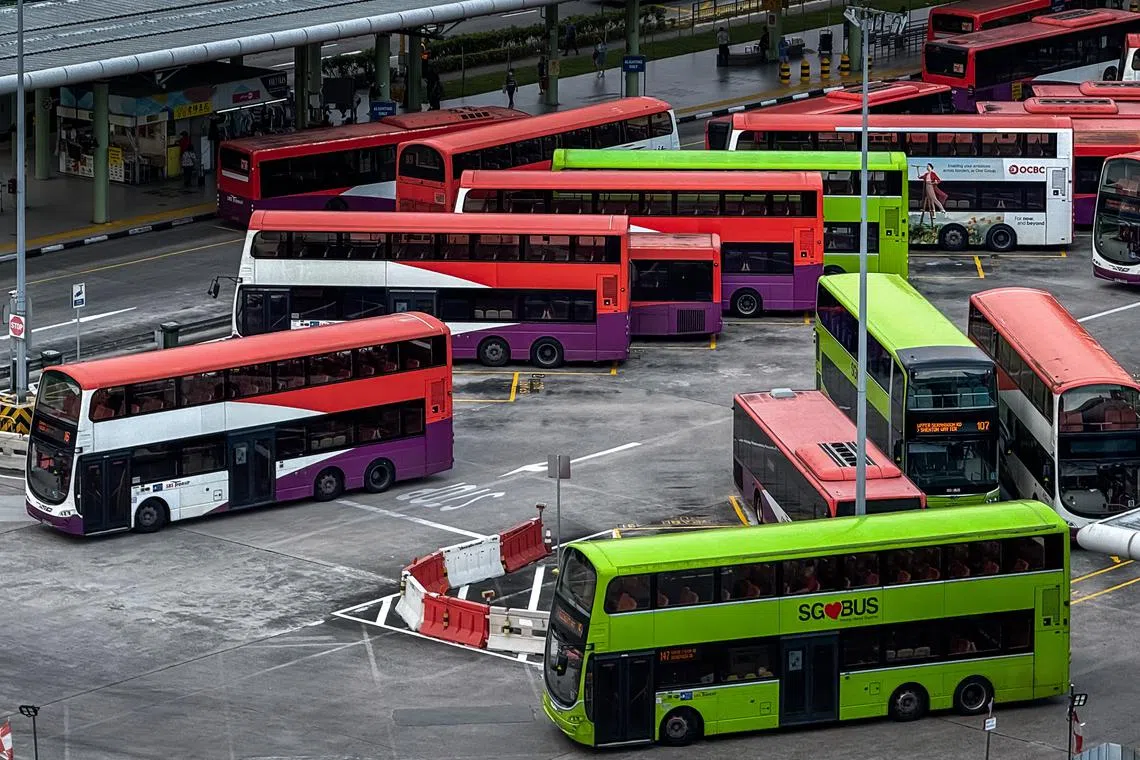Task force recommends capping run times, extending drivers’ meal breaks to improve bus safety
Sign up now: Get ST's newsletters delivered to your inbox

The task force also proposed that LTA work with Singapore’s four public bus operators to offer monetary and other incentives to drivers with good safety records.
ST PHOTO: GAVIN FOO
Follow topic:
SINGAPORE – A task force scrutinising the safety of public buses here has released a raft of recommendations to better support drivers. Among these are equipping buses with a collision warning system, capping the run times of new routes within two hours, and extending drivers’ meal breaks from 25 minutes to 30 minutes.
The task force also proposed that the Land Transport Authority (LTA) work with Singapore’s four public bus operators to offer monetary and other incentives to drivers with good safety records.
The training of bus drivers across the four operators should be tracked, the task force suggested, and all should receive a minimum amount of training each year.
The task force’s recommendations are centred on supporting bus drivers in three broad areas:
Giving them a range of technological tools to help them drive safely
Bettering their working conditions by capping the run time – or the time taken to complete a bus route – to two hours for new routes, and offering safety incentives
Improving the management of road works, which can hinder the movement of buses
These recommendations were accepted by the Government on March 5. The 30-page report is the culmination of a months-long exercise
There are about 9,500 public bus drivers in Singapore who operate 5,800 buses across more than 360 routes. Maintaining a strong safety record for a system of this scale requires sustained and unceasing effort, said Mr Murali on March 5 during the debate on the Ministry of Transport’s budget.
In the task force’s report, Mr Murali wrote that a key insight from the task force’s consultations with bus drivers, members of the public, and local and international safety experts was “the need to pay attention to the human element in issues of safety, in particular, the key role of the driver”.
He noted that drivers face “difficult, split-second decisions”, such as whether to brake hard to avoid a collision at the risk of causing commuters on the bus to fall.
In setting out its recommendations, the task force noted that public buses here are “generally safe”, with the number of serious collisions involving public buses remaining stable in the past few years. “Nevertheless, our engagements identified several areas for improvement which will enable us to sustain and raise our safety standards,” the report said.
New technology for the entire public bus fleet
Some public buses have been equipped with a range of technologies that help drivers drive safely, though these are not evenly distributed across bus operators and bus models.
To remedy this, and take advantage of “more mature” safety technology, the task force recommended that the entire public bus fleet be equipped with three systems.
The first is a 360-degree collision warning system
With AI, this system can detect potential collisions – with pedestrians or other vehicles – from all directions, and send audiovisual alerts to drivers.
About 19 per cent of public buses have a 360-degree camera system installed, though none has the AI capability.
The second is an anti-fatigue system that tracks a driver’s eye movements. It sends audiovisual prompts to the driver – and produces seat vibrations – if their eyes have been closed for two seconds, or if they have been looking away for more than four seconds.
These cues help bus drivers stay alert, the task force noted. Thirty-nine per cent of buses already have this feature.
The third is a camera mirror system, which augments or replaces side mirrors with high-definition cameras. The feed from these cameras is displayed on screens inside the driver’s cabin. This system can reduce blind spots and improve visibility in bad weather, the task force noted. Currently, only 7 per cent of buses have this feature.
In response to feedback from bus drivers that multiple systems and screens could pose a distraction, the task force recommended that LTA “explore how the number of display units in the driving cabin can be reduced”.
In addition to the three systems to be installed fleet-wide, the task force proposed three more safety features that should be rolled out on public buses, where feasible, including pre-recorded safety announcements and torque management software. The latter refers to the control and distribution of engine power to reduce the “jerkiness” of buses.
The task force also suggested a rear electronic display system that indicates when a bus is about to stop, move off or turn. Similar systems are used in Dubai, Seoul and Shanghai, LTA said.
Run times, meal times and time spent in training
Acknowledging the demanding nature of a bus driver’s job, the task force made a number of suggestions to improve the skills and well-being of drivers, the first of which focuses on run time.
Based on feedback from bus drivers, the task force urged LTA not to introduce new routes with a run time of more than two hours. “Longer journeys can result in lapses in concentration and cause stress to bus drivers,” the report noted. “This could increase the risk of accidents occurring.”
LTA and the operators should also look into shortening the run times of 54 routes that are more than two hours long, where feasible, the task force advised.
One possible way to address this is by allowing “mid-route swopping” of bus drivers, LTA said in response to questions from The Straits Times.
But this approach is “operationally challenging and costly”, LTA said, because it will require more labour.
At the same time, the run times of other routes can be increased to give drivers enough time to complete these routes.
“If run times are not scheduled correctly, (drivers) come under pressure to stay on schedule,” Mr Murali said in Parliament.
Since August 2024, the run times of 111 bus routes have been increased to account for heavier traffic and higher ridership, among other factors, the task force noted.
Separately, Transport Minister Chee Hong Tat said 15 bus services will be added in 2025 as part of a $900 million initiative to improve public bus connectivity,
The task force also urged LTA and the operators to make adjustments to allow bus drivers to take their full 25-minute meal break.
On any given day, over 20 per cent of drivers cannot take their full breaks due to longer run times caused by heavy traffic or parking issues at crowded bus interchanges.
LTA, the operators and the National Transport Workers’ Union (NTWU) should also work towards increasing bus drivers’ 25-minute break to 30 minutes, the report said.
The report also touched on training programmes for bus drivers, and recommended introducing an industry-wide point system to make it easier to track the training of bus drivers across the four operators.
For drivers who need additional training, LTA’s Singapore Bus Academy should introduce “a more robust and personalised coaching programme”, the task force suggested.
In addition, LTA and the operators should reward bus drivers with consistent safety records “by offering tiered incentives”, including monetary incentives, the task force suggested.
As part of its review, the task force visited the SAF Transport Command at Sembawang Camp and noted in its report the Singapore Armed Forces’ practice of tailoring training programmes to the needs of individual transport operators.
SAF also provides a monetary incentive to its transport operators for every 3,000km of accident-free driving, the report said.
Better bus stops and management of road works
To make it easier for buses to move off from bus stops, the task force suggested that LTA work with public bus operators to review about 1,600 bus stops and, where needed, introduce bus lanes or bus priority boxes.
This has already been done for the rest of the 5,000-plus bus stops in Singapore.
In Parliament on March 5, Mr Chee said 20km of new bus lanes will be added to the existing 230km in 2025, with more to follow in the coming years.
The task force also recommended that LTA work with bus operators, Traffic Police and Singapore Road Safety Council to make road users aware of measures in place to facilitate the movements of public buses, and to comply with these measures.
The task force recommended raising penalties – demerit points and fines – for contractors who do not comply with road works regulations and so hinder the movement of public buses.
These guidelines, known as the Code of Practice for Traffic Control at Work Zones, include instructions for proper signage, barriers and traffic management plans to protect workers and road users.
The task force said bus drivers struggle to manoeuvre when road marshals do not set up barriers correctly or provide proper instructions.
On this point, the task force said LTA should work with the relevant agencies to “upskill authorised security officers” to perform more complex traffic control duties around worksites, in order to reduce the reliance on auxiliary police officers.
The task force was formed in July 2024 after a spate of accidents involving public buses. It comprised 16 people, including representatives from the Government, the four public bus operators and NTWU.
There were 185 serious collisions involving public buses in 2024, compared with 200 in 2023, and 191 in 2022, the report noted.
A collision is classified as serious when it involves a fatality, an injury requiring conveyance to hospital, or damage of $5,000 or more caused to the bus.
Accidents in which there is a fatality or an injury and the bus driver is found to be at fault are also classified as serious.
The number of accidents in which bus drivers were found to be at fault has remained stable in the past few years, the task force’s report said. There were 93 such accidents in 2024, compared with 99 in 2023, and 85 in 2022.
The group surveyed 3,400 bus drivers and 2,300 members of the public, and held focus-group discussions with 200 people, including bus drivers and other road users.
The task force also held discussions with bus industry experts from Australia, South Korea and the United Kingdom, and went to London to meet experts and operators.
The four public bus operators – SBS Transit, SMRT Buses, Tower Transit Singapore and Go-Ahead Singapore – welcomed the task force’s recommendations and said they would continue to work closely with LTA.
Mr Tan Peng Kuan, managing director of SMRT Buses, said the operator has developed a system that can identify drivers “who may require immediate remedial training” based on telematics data, which tracks the driver’s driving practices.
A training programme is then “tailored to the specific needs of at-risk bus captains”, Mr Tan said.
Vanessa Paige Chelvan is a correspondent at The Straits Times. She writes about all things transport and pens the occasional commentary.


